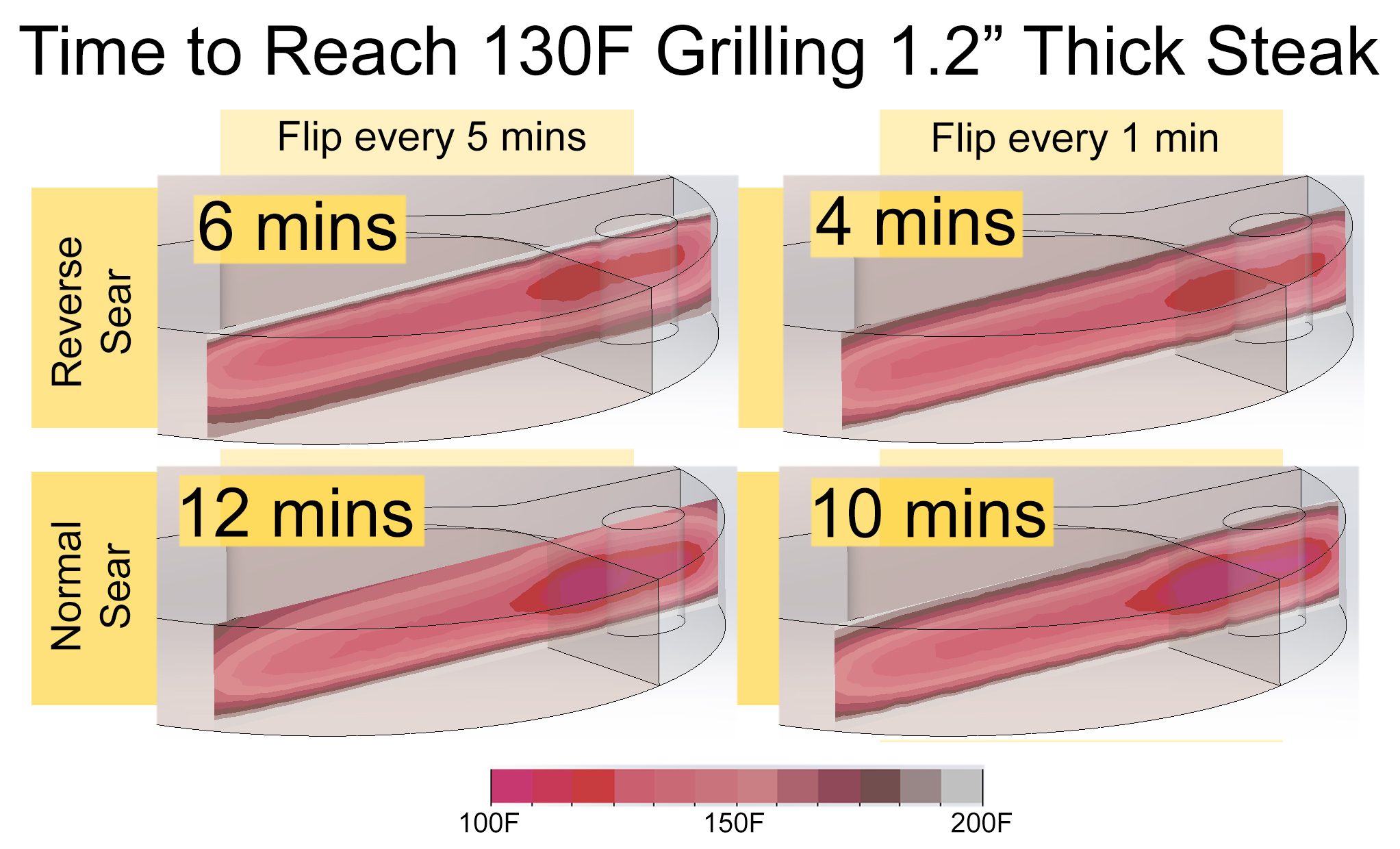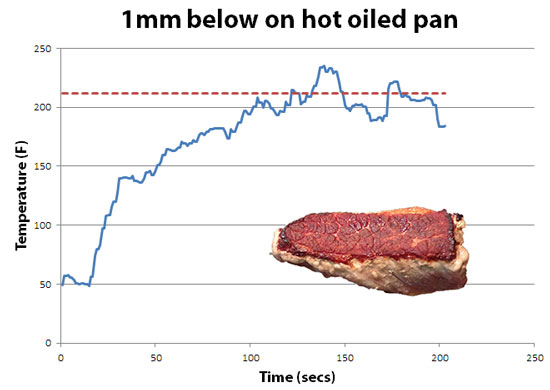| g e n u i n e i d e a s | ||||||
 |
 |
 |
 |
 |
 |
 |
| home | art and science |
writings | biography | food | inventions | search |
| flipping out | ||||||||||||
| April 2016 | ||||||||||||
|
Unfortunately, opportunity slips through the grates all too often. Weekend warriors toss dinner on a hot fire, impale with a fork, and flip when the surface is blackened. Just like their dad taught them. Sliced open, the steak disgorges a rainbow of colors, from overcooked gray near the surface, to undercooked bluish-pink in the center. If, like most chefs, you believe a steak's flavor and texture peaks in a uniformly rare slice, very little of this steak is in the zone. Why did the steak miss the mark? Well, you have to brown the meat's surface over a hot flame to develop a tasty, aromatic crust. This takes heat, lots of heat, applied quickly so the entire steak doesn't turn to charcoal. But, in order to simultaneously cook through to the raw center, that same energy must diffuse from the fire, past the sizzling meat's surface, into the core. Muscle, as luck would have it, is a rather poor thermal conductor (as well as a great absorber) of heat. There is a huge temperature gradient between surface and center when grilling a steak right out of the fridge. A gradient that stubbornly resists leveling out during cooking. Simply trying to force more heat in from the grill merely piles up energy near the surface. The outer 1/4" can easily reach 170F (which is both flavorless and tough), while meat near the bone may be 10F cooler than the center, because bone slightly impedes heat flow. All a consequence of meat's astonishingly poor thermal properties. There must be a better way. Actually, there are two: the FORWARD and the REVERSE sear. Neither is hard to master. The key to each method is separating the searing from the cooking steps. Much has already been written about both of these methods, so I won't cover them in excruciating detail. I've traced their origin back at least half a century to restaurant "cook and hold" yield improvement techniques. Less well appreciated (and contrary to received backyard grill wisdom), is the value of rapidly flipping a steak during grilling. Growing up, I'd always "heard" that flipping ruins the crust and overcooks the meat. Exactly the opposite is true, as Harold McGee pointed out nearly 20 years ago. By combining both methods, you just may achieve steak nirvana. If you plan ahead and salt the night before grilling (around 1/4 tsp table salt per pound of meat), the steak will be especially tender and juicy. I prefer to salt the meat and then let the surface dry out, uncovered, on a rack in the fridge. The drier the surface, the less steam on the grill, and the more pronounced the crust. A slow, low temperature heating step before or after searing assures the interior of the steak (as well as the bones, marrow and fat) all reach the same temperature. Some people claim the slow n' low stage offers time for meat enzymes to tenderize the muscle structure, but evidence for this claim remains elusive. How do both approaches compare?
The reverse sear happened naturally, in the bad-old days, when meat was butchered from a carcass and laid in the hot sun before grilling. Caterers often misuse the forward sear by frying up a few hundred filet mignons, then let them sweat on a steam table for hours before serving. We can do better. But what is the hard science behind steak flipping and reverse searing? In both cases, it has to do with one important fact about heat diffusion. The larger the temperature difference, the faster heat flows. In other words, as the cold steak sears on the hot grill, heat initially travels inward rapidly. But, as the steak warms up, the temperature difference between grill and crust moderates, and so does the cooking rate. Which favors flipping. When you are grilling one side of a steak, the other surface is cooling off a bit as heat diffuses inward. Very little heat enters the air. At the same time, the surface of the grilled side quickly reaches 212F, which slows down heat absorption into the growing, hot gray layer beneath. Eventually you reach a point of diminishing returns, and the best strategy is to flip the relatively cool side back on the hot grill. Think of it like watering a couple of potted plants. When you first sprinkle dry soil with water, it is quickly absorbed. But, the dirt quickly saturates with moisture and soon water barely trickles in. As most gardeners are aware, rather than trying to soak each pot completely, its faster to lightly water pots sequentially, and switch back and forth between pots as the surface water drains. The same is true with grilling. This curve was generated by a computer simulation (see below) of an ice-cold steak on a very hot grill. The orange curve flips the steak once every five minutes-- the blue once every minute. The vertical axis measures how much total heat enters the steak. Note how the orange curve quickly drops as the meat's surface heats up- exactly like the pot watering example. With rapid flipping, note how the blue heat-flow curve is almost always above the orange curve1. In other words, more heat enters by flipping.
Plus, heat enters nearly uniformly from both sides. So flipping is less likely to create a wide, asymmetric, gray band of overcooked meat.
In the images and movie below, we highlight (yellow arrows shown to the right) a cross section of the steak that pass through the bone, marrow and meat. In the reverse sear simulations, the steak was uniformly pre-heated to 110F before tossing on the grill. In the normal grilling case, the steak was "grilled" right out of the fridge, so the interior was pre-cooled to a uniform 35F. Finally, the meat was turned either once a minute, or once every five. Four possible combinations. As you can see in this montage, either reverse-seared steak would be delicious. But, the reverse-seared, pre-warmed and rapidly flipped steak (upper right corner) not only cooked 20%-30% faster, the interior was the most uniform and least banded. Nirvana on a plate:
Compared to simply tossing a steak on the grill fresh out of a Styrofoam tray, reverse sear is a big pain. Hardly worth the effort if the steak is thin or of poor quality. But, if you just spent $25 on a hunk of prime meat, and want to do it justice, salt the night before, pre-heat slowly to 110F and flip over and over on a blisteringly hot griddle. Honor the cow.
|
||||||||||||
|
--------------------------------------------------------------------------------------------------------
In this one minute video, all four methods are compared. Watch the video a few times- you can detect the way heat, on the side of the meat away from the griddle, cools off and evens out, while the griddled side is nearly boiling. Each combination is run until the center of the steak reaches 130F, so they vary in length accordingly (as in the montage above). Note the color bar is similar to the actual color of the cooked steak, but underestimates the gray band that forms as pulses of high temperature enter and diffuse away. To avoid the distraction of a steak flopping over and over like a trained seal, the meat stays put in these simulations, while the heat source is toggled from one surface to the other:
1 I also integrated under these curves and confirmed the total energy absorbed by flipping every one minute is always higher than flipping every five minutes. Around 20% higher when the center is at 130F.
2 Seared on a blisteringly hot frying pan seasoned with a bit of oil, the surface starts browning in seconds. Measured by a probe inserted just a mm below the surface of the meat, the temperature curve jumps around a bit as the steak spits and spurts, and can reach as high as 230F. But still averages around 212F (the dotted red line). Note if you flip once a minute, the first minute just barely has time to fully brown the surface of a cold steak. But the second time on the heat finishes the job. Think 4-6 flips.
Rather amazing that a little bit of steam can protect a steak from contact with a 1000F surface. A testament to water's enormous latent heat of evaporation, plus a bit of Leidenfrost thrown in for good measure. Importantly, the searing time is almost constant, no matter how thick the meat. It's a surface effect. And dumps the same amount of energy into the meat, no matter how thick. But in a thicker steak, that energy spreads out over a large volume, so raises the temperature by a smaller amount than in a thin steak. So a very generous cut (say 2") should be pre-heated to 127F, and the searing will bring it up to 130F. A thinner 1" steak, after the same 4-6 minutes searing time, will rise by 5-10F. Thus a lower pre-heat target temp. When cooking Chinese stir-fry, sear with no pre-heating at all. The optimal technique also depends on how much time you squander between the pre-heat stage and the grill. Once you understand the principle, adapt these insights to your style of cooking and equipment. |
||||||||||||
 Contact Greg Blonder by email here - Modified Genuine Ideas, LLC. |
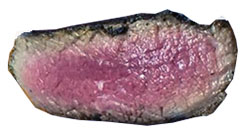 A great steak is a terrible thing to waste.
A great steak is a terrible thing to waste. 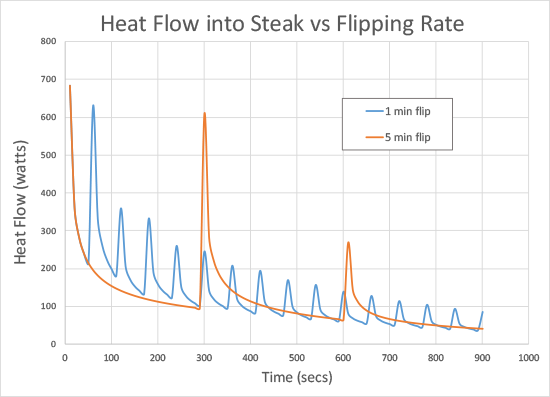
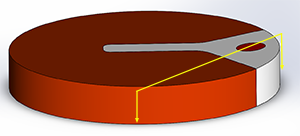 In our simulations, an elliptical "T-bone" steak was created in software. The steak is 30mm (1.2") thick, with a large bone and a small circle of marrow, grilled on a hot surface. Because evaporative cooling limits the steak's surface to 212F, cooking times only weakly depend on temperature once you get the grill above 450F. At that point the surface is always steaming2, and the surface cooks the interior.
In our simulations, an elliptical "T-bone" steak was created in software. The steak is 30mm (1.2") thick, with a large bone and a small circle of marrow, grilled on a hot surface. Because evaporative cooling limits the steak's surface to 212F, cooking times only weakly depend on temperature once you get the grill above 450F. At that point the surface is always steaming2, and the surface cooks the interior.